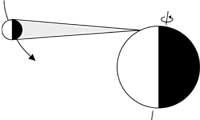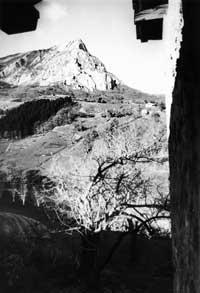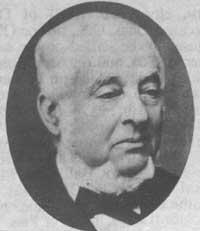May looking at the sky!
1994/05/01 Boneta, Jon Andoni | Razkin, Patxi Iturria: Elhuyar aldizkaria
For some time, this May we will have two eclipses. One is the Solar Eclipse and the other is the Lunar Eclipse. The latter has been more abundant in recent years. The last eclipse of the Sun we have seen has been from 1984. We saw this partially from Euskal Herria, as we will see in May this year. (Figures 1 and 2).
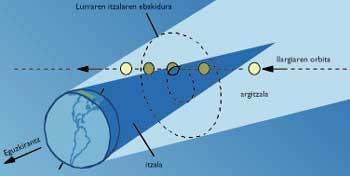
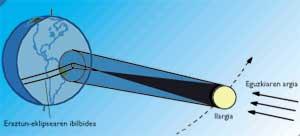
To understand what happens in the eclipse, think that in space we have three spheres, one fixed (the Sun) and the other two (the Earth and the Moon) that move through its orbit. Let us think that the three spheres are on the same plane. When the Moon is between the Sun and the Earth an eclipse of the Sun occurs, that is, the shadow of the Moon will not let us see the Sun. On the contrary, by placing the Earth between the Sun and the Moon, the shadow of the Earth would not allow the solar rays to reflect on the surface of the Moon.
Therefore, once a month we would have both the eclipse of the Moon and the Eclipse of the Sun, since on the Full Moon the Earth would be established between the Sun and the Moon, while on the New Moon the Moon would be the one that would be applied between the Sun and the Earth giving an Eclipse of the Sun.
But the three spheres are not on the same plane. The plane formed by the Earth and the Moon is inclined about 5° to that formed by the Sun and the Earth, as can be seen in figure 3.
When the Moon crosses the plane that composes the Sun and Earth, eclipses occur when the three spheres are aligned (New Moon or Full Moon).
More information about the solar eclipse “Elhuyar. Science and Technology.” Nº53 (November 1991, 43). Page. appears.
Taking into account the two types of eclipses and performing the mean, in a year between 4 and 7 eclipses occur. During this century, 226 Sun Eclipses and 230 Moon Eclipses will occur. It seems that the eclipse is not so difficult to see, but it is still 10 years from the Basque Country that we have not seen an Eclipse of the Sun and will spend another two years before seeing the next one.
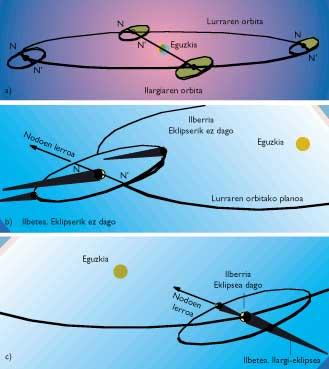
Sun eclipses May 10
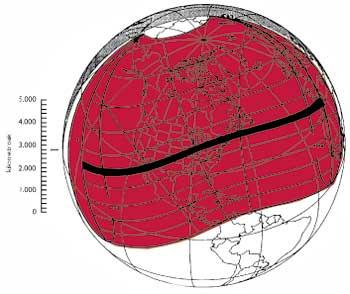
This phenomenon is an eclipse of rings, that is, the Moon does not completely hide the Sun and a kind of ring can be seen. As a ring eclipse, it will only be seen from the black line that appears in Figure 4. This line has a width of 250 km. It will be partial in other regions drawn in red. The closer the black line is, the more the Sun will cover.
As can be seen on the map, the partial eclipse will be seen in the following regions: Central America, Caribbean islands, northwest Africa, western Europe and archaic territories.
In this ring eclipse the march will be: It begins in the Pacific, enters America through the Baja California peninsula and crosses the United States. After passing the azores through the islands, the eclipse ends in Morocco.
In the Iberian peninsula the Moon will cover the Sun from 62 to 87 percent. The beginning of the eclipse will be observed in all peninsular aspects, but before the end of the eclipse the Sun will set.
In Euskal Herria, as can be seen in figure 5, the eclipse will begin at 19 h 42 min., placing the Sun to the Northwest (at 16 ° of the Earth). It is clear, therefore, that in that direction we must seek the maximum possible horizon.
The maximum of the eclipse will occur at 20h 46min, being covered 70 percent of the Sun. The end of the eclipse, on the other hand, will not be visible, as the Sun and the Moon (both at once) begin to set. The hours mentioned have been calculated for Baiona and in any other region of the Basque Country will occur with a minute delay or advance.
The hours of the eclipse will be the following (these figures will be the civil hours of our watches):
Home eclipse 19 h 42 min
Maximum eclipse 20 h 46 min
Sunrise 21 h 18 min
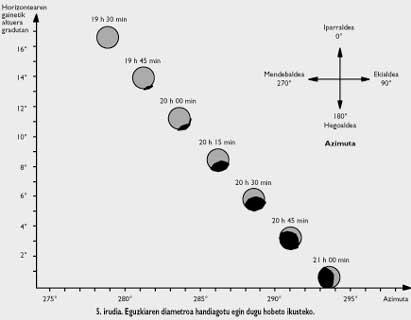
How to see the Solar Eclipse?
Keep in mind that you NEVER and NEVER have to look directly at the Sun. If we look live, the retina of the eye would burn forever. Any device would burn us faster. Therefore, it is very important to consider and not joke.
View
The easiest thing, of course, is to see the eclipse at a glance using the necessary filters. Among them, probably the cheapest and prudent, are the crystals used in welding protections. Finding this material is quite simple and does not exceed 300 pesetas. Depending on the density of the crystal, they are classified by numbers. High density has a higher number and is therefore more impervious to sunlight. Recommended number 14 of all books.
Therefore, to follow the eclipse just put the filter towards the sun. However, it is advisable that the solar observation time does not exceed 10 seconds and let the filter cool for a few minutes. Always keep in mind that we should not force our eyes. Once the excess of brightness is seen, the Sun is stopped and if necessary another filter is placed next to the previous one so that less light passes.
With telescope or binoculars
As mentioned above, NEVER and NEVER look directly at the Sun by means of a device, as in a few seconds we will burn the retina forever. Try it by placing a paper in the place where the rays come out and you will see how it burns like a magnifying glass. Undoubtedly, the most prudent method is projection. About 20 or 30 centimeters from the point of sunrise of the solar ray (ocular) is placed a white sheet in which we project the sun. Once focused on the luminous sphere that appears on the white paper, we are prepared to see the eclipse.
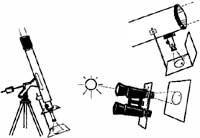
Figure 6 shows how to look with this method.
With our appliances do not look NEVER directly to sunbathe. We will take advantage of the telescope shade or binoculars, get the least shade and have the Sun in the eyepiece. Remember that a second is enough to burn the eye. Therefore, watch out for the instrument when sunbathing and use the shade method.
Finally, we will be careful if our binoculars or telescope have some plastic. More if they have a black color, because in the end it will also burn. For this not to happen, we will see the Sun a little time and then let the telescope cool, returning to the eclipse in a few minutes.
What observations can we make?
Scientifically partial eclipses of the Sun are not of great importance. However, there are some that may be of interest to astronomers, especially because we do not need great tools.
Timing
It consists of timing the different contacts that occur during the eclipse. At present, both the Earth's orbit and the Moon's orbit are precisely known. However, timing is used to determine if a small change occurs. In addition to the contacts between the Sun and the Moon, the stories between the Moon and the spots that can exist in the Sun are interesting, for the same reason mentioned above.
Photos
The easiest thing is to photograph directly the aforementioned projection.
Another way is to exit directly from a telephoto lens (using as much focal length as possible, the most suitable being that of more than 300 mm). But this requires a neutral or similar filter. This type of filters can be too expensive and with this filter is not visible to the eye, since it does not filter harmful radiation (especially infrared). And to take pictures we can not look directly from the camera.
We can also use the weld protection filter mentioned, but it will not cover the entire target. We can fill the part that does not cover us with cardboard, but it is very dangerous if we do not place it well or when the cardboard falls at some point.
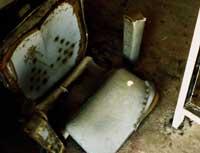
Another interesting photo is the one we see in figure 7. A small hole is made in a cardboard with a needle. Through this hole we pass the Sun and project it in a dark place. This method works as a dark room of cameras in which we see the eclipse projected. It is the safest way to follow the eclipse and take pictures.
Another note about the photos is that we never direct the camera to the Sun and leave the lens uncovered. The force of the Sun is so great that the shutter of the chamber would burn.
Sunspots
As we know, sunspots look black. They are not really like that, but they seem to be black about their surroundings. This is due to the temperature difference. The spots are 1500 ºC colder than the surrounding matter and by this contrast we see them black.
The shadow of the Moon is black. So when the shade approaches the sunspots, we will see the brown spots.
However, lately we are at the minimum of the sunspot cycle, so there are not expected to be many.
Luminosity of the sky
In total eclipses the luminosity of the sky is totally lost and the medium remains as if it were night. This decrease in brightness begins to be noticed when 65% of the Sun is covered. In our eclipse 70% will be covered. Therefore, small changes in brightness may be noticed.
A photometer is sufficient to measure changes in brightness. To make the measurements, we will direct the photometer to the north or south pole to a white wall.
If we did not have photometers, the measurements would be made at first sight. To do this the ideal is to be attentive to the white wall. We can also observe this phenomenon at the intensity reflected in the water, but that is, not look at it directly. Throughout the 1991 Mexican eclipse, many people became obsessed with it.
Pressure and temperature
It is about measuring the pressure and temperature changes that occur in the eclipse. Measuring these changes is very difficult. This is because the weather conditions are very variable.
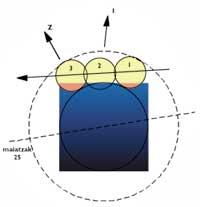
The measures will be carried out in the days near the eclipse and in the hours that occur. Thus we will compare them with the measures in the eclipse.
Wind eclipse
Observers who have seen many eclipses of the Sun indicate that it seems that during the eclipse or in the next few minutes a kind of breeze or wind rises.
If you observe this wind, it is interesting to measure its direction and intensity.
OBSERVATIONS: We must insist that all observations must be made very carefully for the safety of our eyes.
For further explanations or to ensure that the observation you are going to make is not going to harm you, you can go to the Astronomy Department of the Aranzadi Science Society of Donostia.
May 25 partial lunar eclipse
As mentioned, Moon eclipses have been seen more often in recent years. In them it does not happen as in the solar, that is, the eclipse is not seen in small regions. Here when the eclipse occurs, if it is night, you can see.
This eclipse will also be partial, covering 25% of the Moon. Also it will be at the small hours of Wednesday and we will not see the end of the eclipse because the Moon has already begun to enter. Therefore, the eclipse will not have great scientific importance, except for the aforementioned timekeeping.
Below are the data of the different contacts of the eclipse, the shadow of the Earth and the graph of the positions of the Moon.
|
Ephemeris SUN: Enter Gemini on May 21 at 6h 58 min (UT). Eclipse of the Sun: on May 10 we have an eclipse of the Sun. Although in other areas there will be ring eclipse, in our case it will be partial. The first contact will be at 17 h 0 min (UT). So it happens almost at dusk. This eclipse of the Sun is the first one we can see after what happened on May 30, 1984, visible from Euskal Herria. MOON:Recent searches Ilberriailgoror2101825HORA (UT)14 h 32 min17 h 7 min12 h 50 min3 h 39 minMoon eclipse. The pair of the previous Solar Eclipse, also partial, but its magnitude is low, 0.24, that is, the shadow of the Earth will only cover a small part of the Moon. Start at 3h (UT). PLANETS: |

Gai honi buruzko eduki gehiago
Elhuyarrek garatutako teknologia



